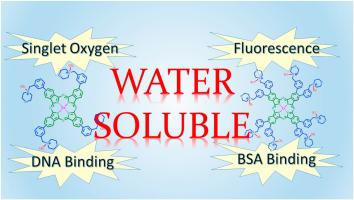Journal of Photochemistry and Photobiology A: Chemistry ( IF 4.1 ) Pub Date : 2020-06-29 , DOI: 10.1016/j.jphotochem.2020.112736 Khaoula Khezami , Kevser Harmandar , Esra Bağda , Efkan Bağda , Gamze Şahin , Nurşen Karakodak , Bassem Jamoussi , Mahmut Durmuş

|
Two new tetra- or octa-substituted zinc(II) phthalocyanines (1 and 2) bearing 3-(morpholinomethyl)phenyl groups were synthesized via Suzuki-Miyaura coupling method. These phthalocyanines (1 and 2) were converted to their water-soluble derivatives (1Q and 2Q) by quaternization of nitrogen atoms on the morpholine groups. The photochemical and photophysical properties of the non-ionic zinc(II) phthalocyanines (1 and 2) were explored in DMSO. On the other hand, these properties of the quaternized cationic derivatives (1Q and 2Q) were studied in both DMSO and aqueous solutions for determination of their photosensitizing capabilities in photodynamic therapy. The ct-DNA interaction of synthesized 1Q and 2Q were investigated and binding constants were found as 6.3 × 104 and 1.5 × 105 M, respectively. The binding constant values were found at similar levels of ethidium bromide (EB), which is a well-known intercalator. The spontaneous and exothermic nature of binding mechanisms were proved according to the calculated thermodynamic constants. Strong interactions of 1Q and 2Q with ct-DNA were also found with EB displacement assay and gel electrophoresis. Additionally, the bovine serum albumin (BSA) binding behavior of the new compounds (1Q and 2Q) were determined in water solution to verify the transporting capability of these phthalocyanines in the circulatory system and these values were found as 7.0 × 105 and 1.6 × 107 M−1 for 1Q and 2Q, respectively.
中文翻译:

吗啉基取代的新型水溶性锌酞菁锌的合成及光学性质
通过Suzuki-Miyaura偶联方法合成了两个带有3-(吗啉代甲基)苯基的新的四或八取代的酞菁锌(II)酞菁(1和2)。通过将吗啉基团上的氮原子季铵化,将这些酞菁(1和2)转化为水溶性衍生物(1Q和2Q)。在DMSO中探索了非离子型酞菁锌(II)(1和2)的光化学和光物理性质。另一方面,季铵化阳离子衍生物(1Q和2Q)在DMSO和水溶液中进行了研究,以确定它们在光动力疗法中的光敏能力。合成的CT-DNA相互作用1Q和2Q进行了研究和结合常数,发现为6.3×10 4和1.5×10 5男,分别。在众所周知的嵌入剂溴化乙锭(EB)的水平上发现了结合常数值。根据计算的热力学常数证明了结合机理的自发性和放热性。一季度和二季度的强大互动EB置换分析和凝胶电泳也发现了带有ct-DNA的DNA。此外,测定了水溶液中新化合物(1Q和2Q)的牛血清白蛋白(BSA)结合行为,以验证这些酞菁在循环系统中的运输能力,这些值为7.0×10 5和1.6× 1Q和2Q分别为10 7 M -1。











































 京公网安备 11010802027423号
京公网安备 11010802027423号